T5-E1 Module Datasheet
Last Updated on : 2025-10-13 08:05:36download
T5-E1 is a highly integrated single-antenna single-band 2.4 GHz Wi-Fi 6 (IEEE 802.11b/g/n/ax) and Bluetooth 5.4 Low Energy (LE) combo IoT module. Featuring a multi-peripheral packaging and ultra-low-power chip, the T5-E1 module provides a highly integrated, efficient, secure, and lowest-power environment for IP cameras, HMI applications, smart locks, and other advanced IoT applications.
The T5-E1-IPEX module is not pin-to-pin compatible with the T5-E1 module.
Features
CPU and on-chip memory
- Built-in with Tuya’s custom T5QN88 chip, Armv8-M Star (M33F) processor, with clock frequency of up to 480 MHz
- 8 MB Flash
- 16 MB PSRAM
- 640 KB Share SRAM
- 64 KB ROM
Wi-Fi
- IEEE 802.11b/g/n/ax compliant
- 20 MHz and 40 MHz channel bandwidth
- Support downlink multi-user multiple input, multiple output (DL MU-MIMO)
- Support orthogonal frequency-division multiple access (OFDMA)
- Support target wake time (TWT)
- Integrated Bluetooth and Wi-Fi coexistence (packet traffic arbitration, PTA)
- Transmit (TX) power up to +20 dBm
- Receive (RX) sensitivity of -99 dBm
- Antenna gain of 3.25 dBi
Bluetooth
- Support Bluetooth LE 5.4 standard
- Support Bluetooth LE 1 Mbit/s and long-range mode (125 Kbit/s and 500 Kbit/s)
- TX power +6 dBm
- RX sensitivity of -97 dBm
- Antenna gain of 3.25 dBi
Peripherals
- 48x GPIOs
- 2x SPIs and 2x QSPIs
- 3x UART interfaces: 1 channel has hardware flow control and supports flash download
- 1x smart card controller
- 1x SDIO interface, 2x I2C interfaces, and 1x CAN controller with CAN FD
- 1x high-speed (HS) USB 2.0 interface
- 1x display controller supporting RGB565 and 8080 interfaces
- 1x segment LCD controller for up to 4 × 32 segments
- 1x 8-bit CIS DVP interface
- 1x 720p H.264 video encoder
- 1x Ethernet MAC interface
- 5x 32-bit PWM channels
- 3x I2S interfaces
- 2x audio ADCs and 1x audio DAC
- 12-bit AUX ADC, up to 11 channels
- 1x touch sensor, up to 16 touch sensing I/Os
Antenna type
- Onboard antenna
Operating conditions
- Operating/supply voltage range: 2.0V to 3.6V
- Operating temperature range: -40°C to 85°C
Module certification
- Wi-Fi & Bluetooth: FCC and CE
- Environmental certification: REACH/RoHS
- Bluetooth certification: BQB
Reliability test
- High and low temperature, high temperature and high humidity, high temperature, and cold start tests
- Salt spray and electrostatic discharge tests
Scope of applications
- Human-machine interaction (HMI) application
- Home appliance
- Air conditioner
- Refrigerator
- Thermostat
- Dishwasher
- Robot vacuum
- Smart socket
- Smart lighting
- Industrial wireless control
- Baby monitor
- IP camera and smart lock
- Smart bus
Pin definition
Pin layout
The pin layout diagram shows the approximate location of the pins on the module. For the actual layout drawn to scale, refer to the module dimensional drawings. The top view looks like this:
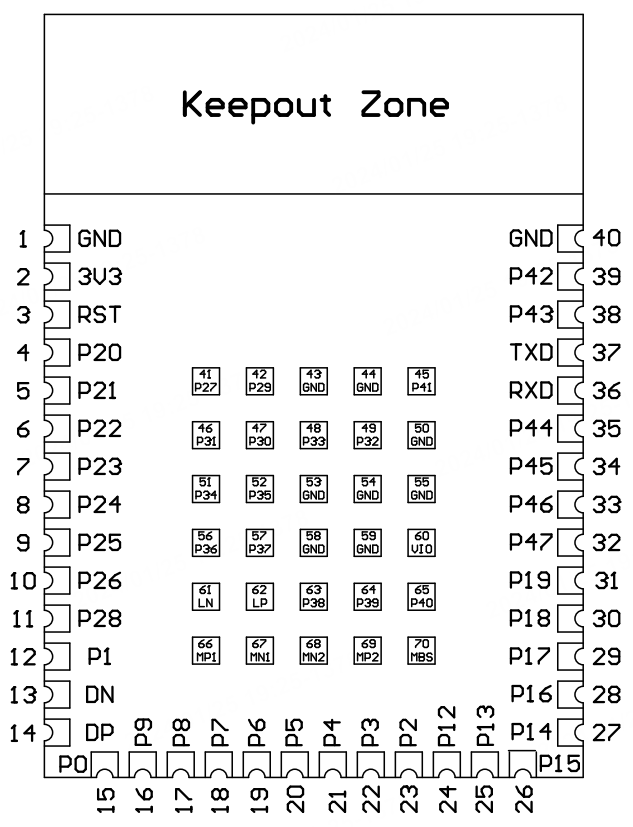
Pin definition
The module has a total of 70 pins. For a detailed description, refer to the table below.
| No. | Name | I/O type | Description |
|---|---|---|---|
| 1 | GND | P | Ground pin |
| 2 | 3V3 | P | Power pin |
| 3 | RST | I | The low-level reset pin, active low, and pulled up internally |
| 4 | P20 | I/O |
|
| 5 | P21 | I/O |
|
| 6 | P22 | I/O |
|
| 7 | P23 | I/O |
|
| 8 | P24 | I/O |
|
| 9 | P25 | I/O |
|
| 10 | P26 | I/O |
|
| 11 | P28 | I/O |
|
| 12 | P1 | I/O |
|
| 13 | DN | I/O | USB D- |
| 14 | DP | I/O | USB D+ |
| 15 | P0 | I/O |
|
| 16 | P9 | I/O |
|
| 17 | P8 | I/O |
|
| 18 | P7 | I/O |
|
| 19 | P6 | I/O |
|
| 20 | P5 | I/O |
|
| 21 | P4 | I/O |
|
| 22 | P3 | I/O |
|
| 23 | P2 | I/O |
|
| 24 | P12 | I/O |
|
| 25 | P13 | I/O |
|
| 26 | P15 | I/O |
|
| 27 | P14 | I/O |
|
| 28 | P16 | I/O |
|
| 29 | P17 | I/O |
|
| 30 | P18 | I/O |
|
| 31 | P19 | I/O |
|
| 32 | P47 | I/O |
|
| 33 | P46 | I/O |
|
| 34 | P45 | I/O |
|
| 35 | P44 | I/O |
|
| 36 | RXD | I/O |
|
| 37 | TXD | I/O |
|
| 38 | P43 | I/O |
|
| 39 | P42 | I/O |
|
| 40 | GND | P | Ground pin |
| 41 | P27 | I/O |
|
| 42 | P29 | I/O |
|
| 43 | GND | P | Ground pin |
| 44 | GND | P | Ground pin |
| 45 | P41 | I/O |
|
| 46 | P31 | I/O |
|
| 47 | P30 | I/O |
|
| 48 | P33 | I/O |
|
| 49 | P32 | I/O |
|
| 50 | GND | P | Ground pin |
| 51 | P34 | I/O |
|
| 52 | P35 | I/O |
|
| 53 | GND | P | Ground pin |
| 54 | GND | P | Ground pin |
| 55 | GND | P | Ground pin |
| 56 | P36 | I/O |
|
| 57 | P37 | I/O |
|
| 58 | GND | P | Ground pin |
| 59 | GND | P | Ground pin |
| 60 | VDDGPIO | AO | GPIO LDO output |
| 61 | LN | AO | Audio channel negative output |
| 62 | LP | AO | Audio channel positive output |
| 63 | P38 | I/O |
|
| 64 | P39 | I/O |
|
| 65 | P40 | I/O |
|
| 66 | MP1 | AI | Microphone 1 positive input |
| 67 | MN1 | AI | Microphone 1 negative input |
| 68 | MN2 | AI | Microphone 2 negative input |
| 69 | MP2 | AI | Microphone 2 positive input |
| 70 | MBS | AO | Microphone bias output |
- The maximum input level of the ADC port is 1.03 V. It is recommended to use MΩ level external voltage divider resistors and place a 100 nF ground filter capacitor close to the ADC port.
Pindicates the power pin.I/Oindicates the input and output pin.AIindicates the analog signal input pin.AOindicates the analog signal output pin.
Electrical parameters
Absolute electrical parameters
| Parameter | Description | Minimum value | Maximum value | Unit |
|---|---|---|---|---|
| Ts | Storage temperature | -55 | 125 | °C |
| VBAT | Supply voltage | -0.3 | 3.6 | V |
| Electrostatic discharge voltage (human body model) | TAMB -25°C | -4 | 4 | kV |
| Electrostatic discharge voltage (machine model) | TAMB -25°C | -200 | 200 | V |
Normal operating conditions
| Parameter | Description | Minimum value | Typical value | Maximum value | Unit |
|---|---|---|---|---|---|
| Ta | Operating temperature | -40 | - | 85 | °C |
| VBAT | Supply voltage | 2.0 | 3.3 | 3.6 | V |
| VOL | I/O low-level output | VSS | - | VSS + 0.3 | V |
| VOH | I/O high-level output | VBAT − 0.3 | - | VBAT | V |
| Imax | I/O drive current | - | 6 | 20 | mA |
| θ | Supply voltage slope | 100 | - | - | mV/ms |
Radio frequency (RF) power
| Operating status | Mode | Rate | Transmit/Receive power | Average value | Peak (Typical) value | Unit |
|---|---|---|---|---|---|---|
| Transmit | 11B | 11 Mbit/s | +17 dBm | - | 322 | mA |
| Transmit | 11G | 54 Mbit/s | +15 dBm | - | 275 | mA |
| Transmit | 11N | HT20 MCS7 | +14 dBm | - | 265 | mA |
| Transmit | 11AX | HE20 MCS7 | +14 dBm | - | 264 | mA |
| Receive | 11B | 11 Mbit/s | Continuous reception | - | 23 | mA |
| Receive | 11G | 54 Mbit/s | Continuous reception | - | 23 | mA |
| Receive | 11N | HT20 MCS7 | Continuous reception | - | 23 | mA |
| Receive | 11AX | HE20 MCS7 | Continuous reception | - | 23 | mA |
In order to test the transmitting operating current, the module is in the state of sending packets at 100% duty cycle.
Operating current
| Operating mode | Status (Ta = 25°C) | Average value | Max (Typical) value | Unit |
|---|---|---|---|---|
| Bluetooth pairing | The module is in pairing over Bluetooth. The network status indicator blinks slowly. | 58 | 290 | mA |
| AP pairing | The module is in AP mode. The network status indicator blinks slowly. | 60 | 292 | mA |
| Weakly connected | The connection between the module and the hotspot is intermittent. The network status indicator blinks quickly. | 120 | 310 | mA |
| Connected | The module is connected to the cloud. The network status indicator is steady on. | 32 | 260 | mA |
| Disconnected | The module is disconnected from the cloud. The network status indicator is steady off. | 40 | 270 | mA |
| Module disabled | The module’s clock enable (CEN) pin is pulled down. | 133 | - | μA |
The above data module is powered by a 3.3 V regulated power supply with firmware v1.0.9. There are slight differences in test data under different test environment conditions.
RF parameters
Basic RF features
| Parameter | Description |
|---|---|
| Operating frequency | 2.412 to 2.484 GHz |
| Wi-Fi standard | IEEE 802.11b/g/n/ax (channels 1–14) |
| Data transmission rate |
|
| Antenna type | PCB antenna with a gain of 3.25 dBi |
Wi-Fi transmitter (TX) performance
| Parameter | Minimum value | Typical value | Maximum value | Unit |
|---|---|---|---|---|
| RF average output power, 802.11b CCK mode, 11 Mit/s | 15 | 17 | 19 | dBm |
| RF average output power, 802.11g OFDM mode, 54 Mbit/s | 13 | 15 | 17 | dBm |
| RF average output power, 802.11n OFDM mode, HT20 MCS7 | 12 | 14 | 16 | dBm |
| RF average output power, 802.11n OFDM mode, HT40 MCS7 | 11 | 13 | 15 | dBm |
| RF average output power, 802.11ax OFDMA Mode, HE20 MCS7 | 12 | 14 | 16 | dBm |
| RF average output power, 802.11ax OFDMA Mode, HE40 MCS7 | 11 | 13 | 15 | dBm |
| Frequency error | -20 | - | 20 | ppm |
Wi-Fi receiver (RX) performance
| Parameter | Minimum value | Typical value | Maximum value | Unit |
|---|---|---|---|---|
| PER < 8%, RX sensitivity, 802.11b DSSS mode, 11 Mbit/s | - | -88 | - | dBm |
| PER < 10%, RX sensitivity, 802.11g OFDM mode, 54 Mbit/s | - | -74 | - | dBm |
| PER < 10%, RX sensitivity, 802.11n OFDM mode, HT40 MCS7 | - | -73 | - | dBm |
| PER < 10%, RX sensitivity, 802.11ax OFDMA Mode, HE40 MCS7 | - | -73 | - | dBm |
| PER < 10%, RX sensitivity, Bluetooth LE, 1 Mbit/s | - | -97 | - | dBm |
Bluetooth transmitter (TX) performance
| Parameter | Minimum value | Typical value | Maximum value | Unit |
|---|---|---|---|---|
| Operating frequency | 2402 | - | 2480 | MHz |
| Transmission rate over the air | - | - | - | Mbit/s |
| Transmission power | -20 | 6 | 15 | dBm |
| Frequency error | -150 | - | 150 | KHz |
Bluetooth receiver (RX) performance
| Parameter | Minimum value | Typical value | Maximum value | Unit |
|---|---|---|---|---|
| RX sensitivity | - | -97 | - | dBm |
| Max RF signal input | -10 | - | - | dBm |
| Intermodulation | - | - | -23 | dBm |
| Adjacent-channel rejection ratio | - | 10 | - | dB |
Antenna information
Antenna type
The T5-E1 module uses an onboard PCB antenna with a gain of 3.25 dBi.
Antenna interference reduction
When a PCB antenna is used on a Wi-Fi module, we recommend that the module antenna is at least 15 mm away from other metal components. This can optimize the Wi-Fi performance.
Make sure that the enclosure surrounding the antenna is not traced or filled with copper. Otherwise, the RF performance might be degraded. According to the antenna shape of the T5-E1 module, you can choose Position 3 or Position 4 (optimal) when using the module.

Development guide
MCU integration
For more information about MCU integration solutions, see Hardware Design of CBx Series Modules.
Packing and production instructions
Mechanical dimensions
The T5-E1 dimensions are 18.00±0.35 mm (W) × 25.50±0.35 mm (L) × 2.8±0.15 mm (H).

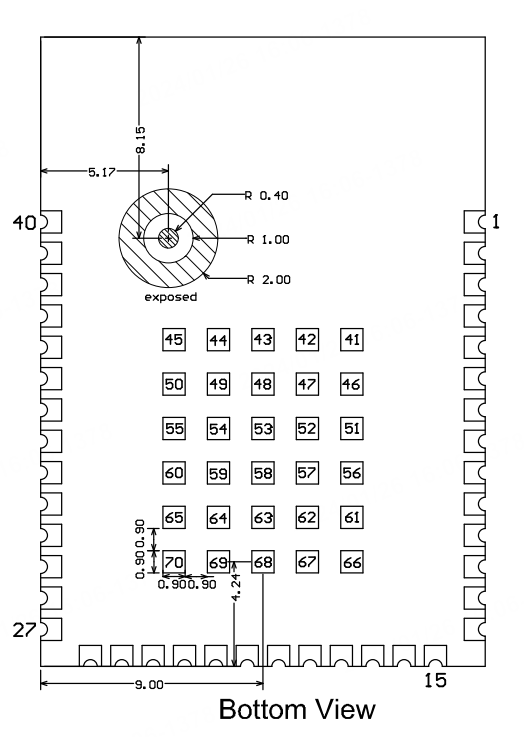
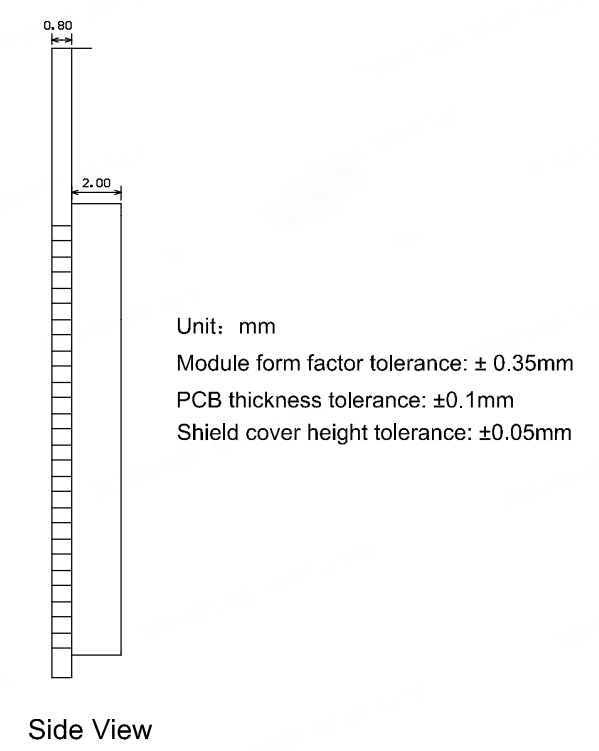
Recommended footprint
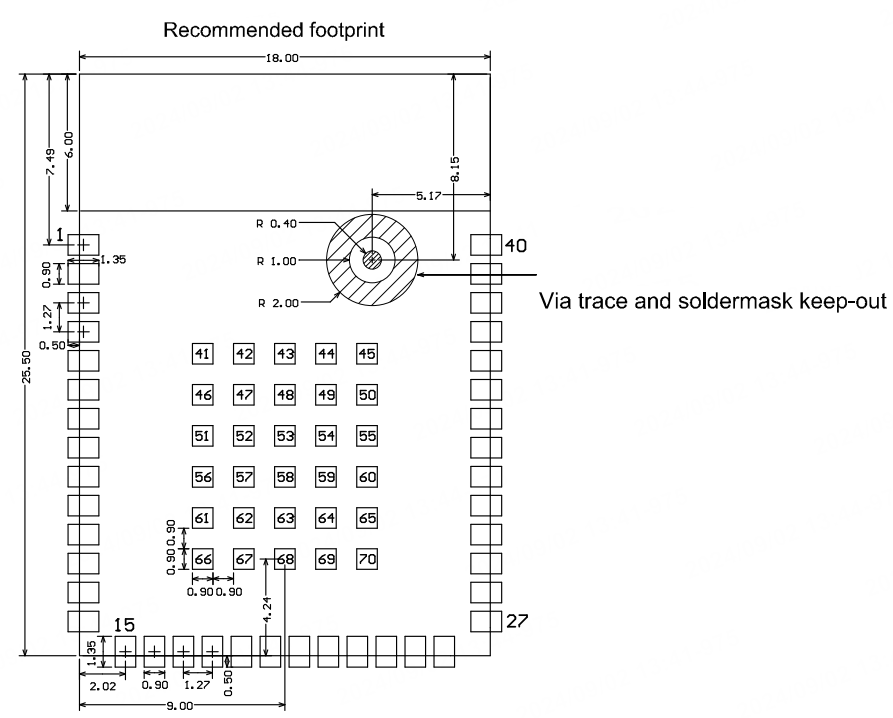
The area indicated as keep-out in the diagram above does not require tinning and should not have any traces routed through it.
Production instructions
-
Package the module with the SMT if Tuya’s module is designed to be SMT-packaged. After being unpacked, the module must be soldered within 24 hours. Otherwise, it needs to be put into a drying cupboard with a relative humidity level no greater than 10%, or pack the module in vacuum again. Then, record the packing time and duration of exposure. The total exposure time cannot exceed 168 hours.
- Instruments or devices required for the SMT process:
- Surface mount system
- SPI
- Reflow soldering machine
- Thermal profiler
- AOI
- Instruments or devices required for the baking process:
- Cabinet oven
- Electro-static discharge (ESD) protection and heat-resistant trays
- ESD protection and heat-resistant gloves
- Instruments or devices required for the SMT process:
-
A delivered module must meet the following storage requirements:
-
The moisture-proof bag must be placed in an environment where the temperature is below 40°C and the relative humidity is lower than 90%.
-
The shelf life of a dry-packaged product is 12 months from the date when the product is packaged and sealed.
-
A humidity indicator card (HIC) is put in the sealed package.
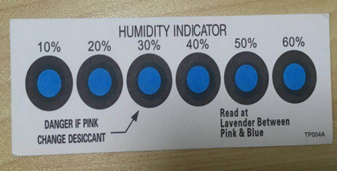
-
-
The module needs to be baked in the following cases:
- The vacuum packaging bag is damaged before unpacking.
- After unpacking, no HIC is found in the packaging bag.
- After unpacking, the HIC indicates a humidity level of 10% or higher. In this case, the circle turns pink on the HIC.
- The total exposure time has lasted for over 168 hours since unpacking.
- More than 12 months have passed since the first sealing of the bag.
-
The baking parameter settings are described below:
- Baking temperature: 40°C for reel packaging with relative humidity ≤ 5%. And 125°C for tray packaging with relative humidity ≤ 5% (use a heat-resistant tray, rather than plastic containers).
- Baking time: 168 hours for reel packaging and 12 hours for tray packaging.
- Temperature for triggering an alert: 50°C for reel packaging and 135°C for tray packaging.
- Production can begin after a module has cooled down to below 36°C under natural conditions.
- If a module remains unused for over 168 hours after being baked, it needs to be baked again.
- If a batch of modules is not baked after exposure for more than 168 hours, do not use wave soldering to solder them. Because these modules are level-3 moisture-sensitive devices, they are very likely to get damp when exposed beyond the allowable time. In this case, if they are soldered at high temperatures, device failure or poor soldering performance might occur.
-
In the whole production process, take electrostatic discharge (ESD) protective measures.
-
To guarantee the pass rate, we recommend that you use the SPI and AOI to monitor the quality of solder paste printing and mounting.
Recommended oven temperature curve
Set the temperature according to the following temperature curve of reflow soldering. The peak temperature is 245°C.
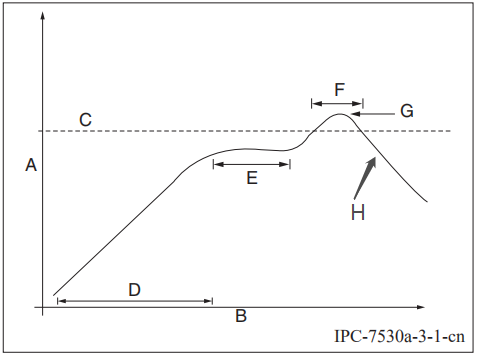
-
A: temperature axis
-
B: time axis
-
C: alloy liquidus temperature from 217°C to 220°C
-
D: ramp-up slope from 1°C/s to 3°C/s
-
E: keep a constant temperature from 150°C to 200°C for a time period from 60s to 120s
-
F: temperature above liquidus temperature for 50s to 70s
-
G: peak temperature from 235°C to 245°C
-
H: ramp-down slope from 1°C/s to 4°C/s
The curve above is based on solder paste SAC305. For more information about other solder pastes, see the recommended oven temperature curve in the specified solder paste specifications.
Storage conditions
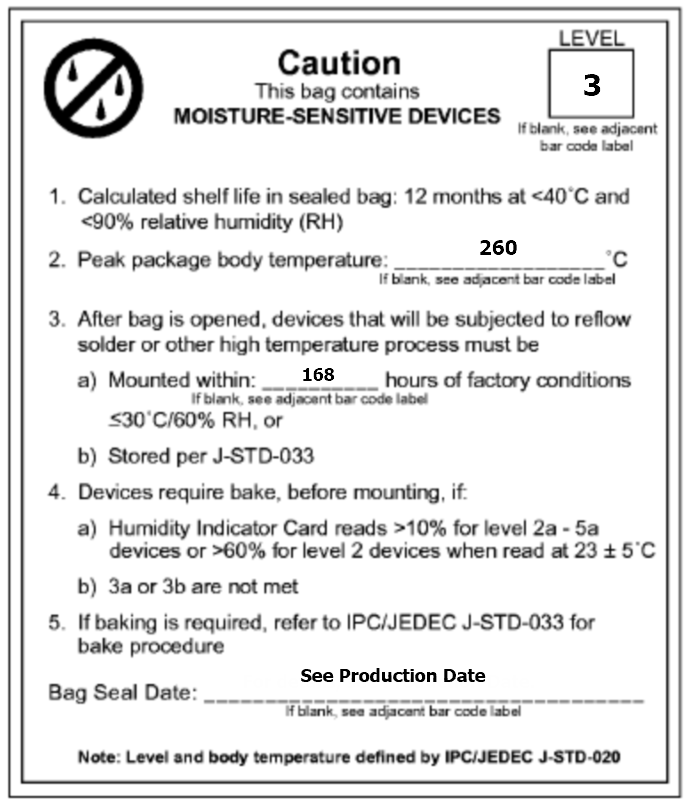
MOQ and packaging information
| Product model | MOQ (pcs) | Shipping packaging | Modules per reel | Reels per carton |
|---|---|---|---|---|
| T5-E1 | 3600 | Tape and reel | 900 | 4 |
Appendix: Statement
FCC Caution: Any changes or modifications not expressly approved by the party responsible for compliance could void the user’s authority to operate this device.
This device complies with Part 15 of the FCC Rules. Operation is subject to the following two conditions: (1) This device may not cause harmful interference, and (2) this device must accept any interference received, including interference that may cause undesired operation.
Note: This device has been tested and found to comply with the limits for a Class B digital device, according to part 15 of the FCC Rules. These limits are designed to provide reasonable protection against harmful interference in a residential installation. This device generates, uses, and can radiate radio frequency energy and, if not installed and used following the instructions, may cause harmful interference to radio communications. However, there is no guarantee that interference will not occur in a particular installation.
If this device does cause harmful interference to radio or television reception, which can be determined by turning the device off and on, the user is encouraged to try to correct the interference by one or more of the following measures:
- Reorient or relocate the receiving antenna.
- Increase the separation between the device and receiver.
- Connect the device into an outlet on a circuit different from that to which the receiver is connected.
- Consult the dealer or an experienced radio/TV technician for help.
Radiation Exposure Statement
This device complies with FCC radiation exposure limits set forth for an uncontrolled rolled environment. This device should be installed and operated with a minimum distance of 20cm between the radiator and your body.
Important Note
This radio module must not be installed to co-locate and operate simultaneously with other radios in the host system except by following FCC multi-transmitter product procedures. Additional testing and device authorization may be required to operate simultaneously with other radios.
The availability of some specific channels and/or operational frequency bands are country-dependent and are firmware programmed at the factory to match the intended destination. The firmware setting is not accessible to the end-user.
The host product manufacturer is responsible for compliance with any other FCC rules that apply to the host not covered by the modular transmitter grant of certification. The final host product still requires Part 15 Subpart B compliance testing with the modular transmitter installed.
The end-user manual shall include all required regulatory information/warnings as shown in this manual, including “This product must be installed and operated with a minimum distance of 20 cm between the radiator and user body”.
This device has got an FCC ID: 2ANDL-T5-E1. The end product must be labeled in a visible area with the following: “Contains Transmitter Module FCC ID: 2ANDL-T5-E1”.
This device is intended only for OEM integrators under the following conditions:
The antenna must be installed such that 20cm is maintained between the antenna and users, and the transmitter module may not be co-located with any other transmitter or antenna.
As long as the 2 conditions above are met, further transmitter tests will not be required. However, the OEM integrator is still responsible for testing their end-product for any additional compliance requirements required with this module installed.
Declaration of Conformity European Notice

Hereby, Hangzhou Tuya Information Technology Co., Ltd declares that this module product is in compliance with essential requirements and other relevant provisions of Directive 2014/53/EU,2011/65/EU. A copy of the Declaration of Conformity can be found at https://www.tuya.com.

This product must not be disposed of as normal household waste, in accordance with the EU directive for waste electrical and electronic equipment (WEEE-2012/19/EU). Instead, it should be disposed of by returning it to the point of sale, or to a municipal recycling collection point.
The device could be used with a separation distance of 20cm from the human body.
Is this page helpful?
YesFeedbackIs this page helpful?
YesFeedback





